Cory Catfish (also known as Corydoras, Cory Cats, and Armored Catfish) are one of the most popular species in freshwater fish-keeping.
They are loved by aquarists of all skill levels for their mild temperament, gentle nature, and unique characteristics.
In this complete guide, we break down everything you need to know about keeping, breeding, and caring for Cory Catfish.
If you are looking for a specific section, use the quick links below to skip around the page for quicker reading. Lets dive in!
| Common Name | Cory Catfish |
| Scientific Name | Corydoras |
| Family | Callichthyidae |
| Care Level | Easy |
| Color | Variety of Natural Shades |
| Size | 2″ |
| Lifespan | 7-12 Years |
| Diet | Omnivore |
| Suggested Tank Size | 20 gallons |
| Water Temperature Requirements | 70° – 80°F |
| pH Requirements | 6.0 – 8.0 |
| Temperament & Compatibility | Very Peaceful |
| Breeding | Easy |
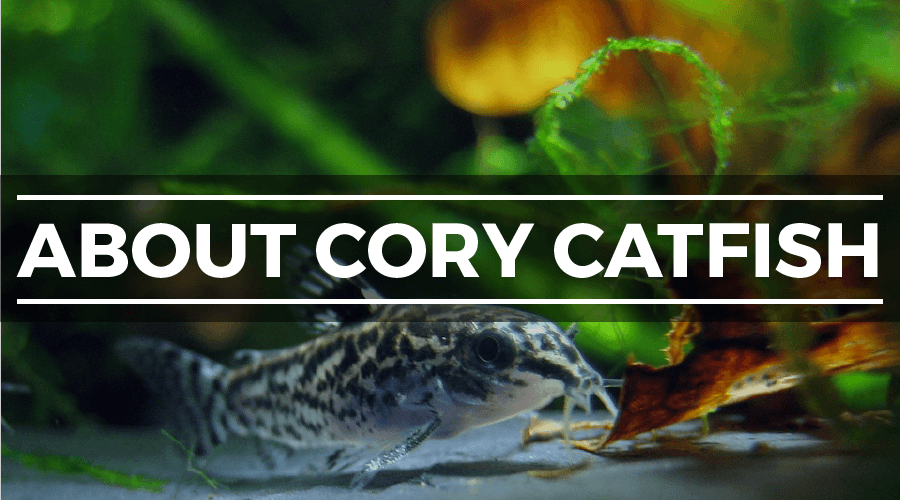
About Cory Catfish
- Scientific Name: Corydoras
- Temperament: Peaceful
- Care Level: Easy
- Origin: South America
- Common Names: Cory Catfish, Corydoras, Cory Cats, Armored Catfish
Temperament
When it comes to temperament, Cory Catfish are one of the most desirable fish in the hobby. Their peaceful and calm demeanor is almost endearing.
In addition, Corydoras get along with just about every species – that said, they are very non-aggressive and usually won’t “stick up for themselves”, so don’t keep them with aggressive tank mates.
Don’t assume that Corydoras’ well-mannered behavior means that they’re boring, though. Cory Catfish are active and entertaining to watch at all hours of the day.
They are an extremely social fish and should be kept in groups of 5 or more – trust me, watching your Corydoras interact with each other is unlike any other fish in the hobby.
Natural Habitat
Cory Catfish originate from small streams and lakes in South America.
Their natural habitat is rich with live plants and other hiding places, so try to recreate that as best as possible.
Another important note about the natural habitat of Cory Catfish is they they are much more comfortable with sand substrates than gravel/rocky substrates.
Gravels and other rough substrates are not recommended because they have the tendency to damage Corydoras’ barbels and fins.
Lifespan
A lot of references claim that Corydoras live between 5-7 years. While this might be true in the wild, Cory Catfish can actually live much longer in captivity.
In the right conditions, Cory catfish are know to live between 12-15 years. There are even some documented cases of aquarium owners keeping Corys for 20+ years!
Size
Corydoras are pretty small for catfish standards. In general, Cory Catfish size usually ranges from 1.5 to 2.5 inches (4-7 cm) depending of the species.
That said, breeding females can reach 3+ inches in older age.
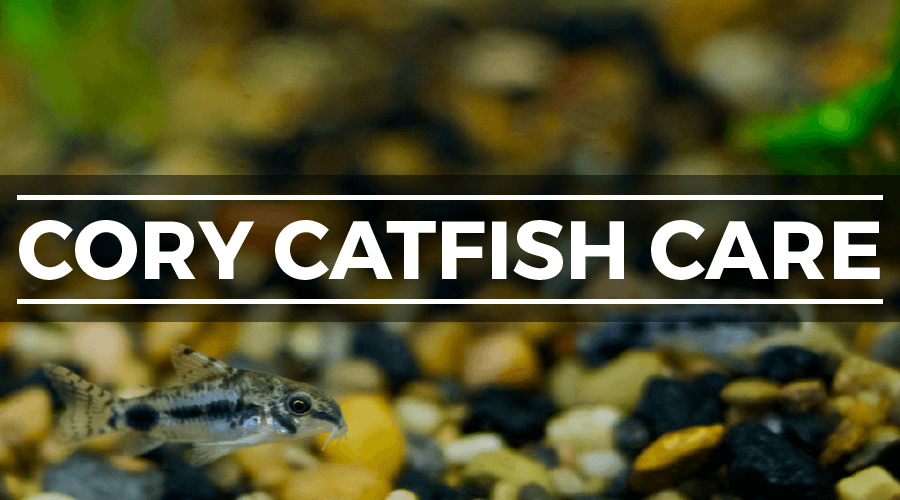
Cory Catfish Care
Here are a few things you should know before attempting to keep Cory Catfish:
Tank Setup Requirements
Cory Catfish are generally pretty easy to care for. They don’t require large tank (much smaller that most other species of catfish) and are pretty forgiving when it comes to water condition.
Cory Catfish also get along great with other species – this combination makes them great for beginner fish-keepers.
- Tank Size: Cory Catfish are pretty small fish. Technically, a single Cory should be fine in a ten gallon tank. The problem is that Corydoras are not happy when kept by themselves. Since they are schooling fish, Cory catfish should be kept in groups of 5 or more. For a school of 5 Corys, a minumim tank size of 20 gallons is recommended.
- Water Flow: Cory Catfish love water flow and are often found “dancing” in areas with high flow. That said, try to have a few spots in your tank with low water flow so your Corys can rest (rock, slate and plants are a great way to do this).
Water Parameters
Wild caught Cory catfish are know to be pretty picky when it comes to water condition – over the years, though, selective breeding has “toughened” tank bred Cory catfish into an extremely resilient and hardy species.
While I wouldn’t describe Corydoras as “difficult” to keep, every effort should be made to provide a pristine environment.
Here are some basic guidelines for water parameters when keeping these fish:
- pH: 6.0-8.0
- Temperature: 70-80°F
- Alkalinity: 3°-10° dKH
When caring for Cory catfish, stability is much more important than hitting that perfect pH and temperature.
If you’re parameters are a few degrees off, don’t worry about it too much – DO try to keep it as stable as possible.
Cory catfish are also especially sensitive to ammonia, nitrite, and nitrate. The first two are the most important – ammonia and nitrite can kill in no time.
This should go without saying, but make sure your tank is properly cycled before introducing any fish to your tank, let alone Corydoras.
Nitrate is a little more sneaky, though. It builds up in the water over time, even in perfectly healthy aquariums. Keep up with bi-weekly water changes to help bring nitrate levels down to safe levels.
The API Freshwater Master Test Kit is the best kit on the market for testing your aquarium water.
Cory Catfish Diet
Typical of any bottom feeder, Corydoras are amazing scavengers. In community tanks, they often find the majority of their food scouring the tank bottom.
That said, Cory catfish owners should never assume that their fish get enough food simply from leftover scraps.
Since Corydoras are omnivorous, they should be fed a balanced diet of plants-based and meat-based foods.
Personally, I have found Hikari Algae Wafers to be a Cory favorite (most flake foods are also sufficient). For the occasional meaty snack, Omega One Bloodworms are a great choice.
Since Corydoras are a little sensitive to changes in ammonia, nitrite, and nitrate, make sure you don’t overfeed. Only feed your fish as much as they can eat in a few minutes and remove anything they don’t seem to like.
Schooling Tendencies of Corydoras
We touched on this a little before, but it is very important that you keep Cory catfish in schools of 4 or more fish (5+ is preferable).
Corys are very social fish and can often be found “playing” and swimming in sync with others of their species. Their schooling antics are not only interesting and amazing to watch, but actually help make your catfish happier and healthier.
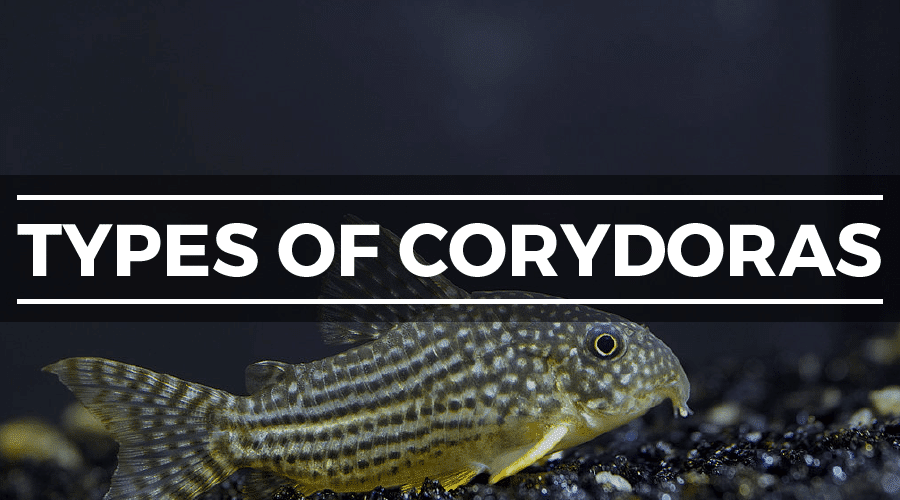
Cory Catfish Types – Common Species
There are over 170 different species of Corydoras Catfish, many of which haven’t even been named yet. When choosing a species for your tank, there are tons of different options.
Here are a few of our favorite Corydora species:
Panda Cory
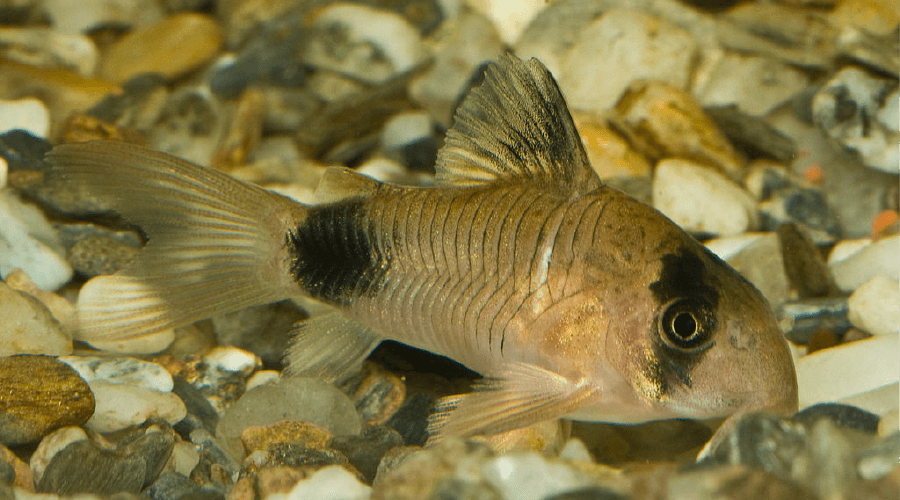
Panda Corys are one of the most popular species of Cory catfish, so they’re readily available at most local fish stores.
They are characterized by a cream-white body with dark black spots on their head and tail. Panda Corydoras grow to about 2″, though breeding-age females may get a little bit larger.
- Scientific Name: Corydoras panda
- Size: 2″
- pH: 6.0-7.0
- Temperature: 70-78°F
Albino Cory
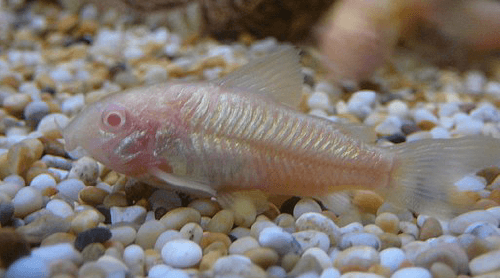
Albino Cory Catfish aren’t technically their own species – they are a selective-bred variation of the Bronze Cory. That said, Albino Corys are unique in more than a few ways.
Their golden-white bodies and light pink eyes create great contrast against plants and dark substrates, making them a popular pick among cory-lovers. In addition, Albino Corys are known for their “spazzy” personalities, which many aquarium owners find endearing.
- Scientific Name: Corydoras aeneus
- Size: 2.5″
- pH: 6.0-7.0
- Temperature: 72-80°F
Peppered Cory
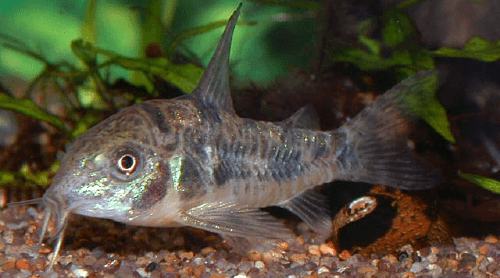
As one of the most popular species of Corydoras, Peppered Corys can be found at most fish stores and online fish retailers.
Their coloration is generally tan with dark green and black patterns (and often a green “shine”). That said, no two Peppered Corys are the same – a trait that a lot of aquarium owners love.
- Scientific Name: Corydoras paleatus
- Size: 2.5-3″
- pH: 6.0-7.0
- Temperature: 72-80°F
Bronze Cory
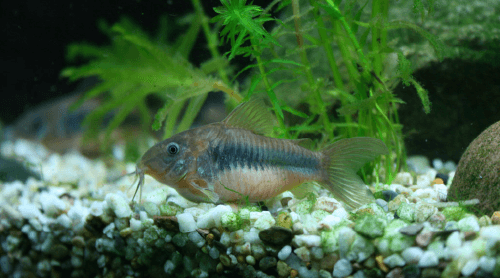
Bronze Corys (a color variation of Green Corys) are known for being active, expressive, and easy to keep – even when compared to other Corydoras species.
They generally grow to about 2.5 inches (6.35 cm), though breeding females can grow to over 3 inches.
Though the coloration of Bronze Corys may not be as attractive as the other species on our list, they are a great choice for aquarists looking to learn about keeping and breeding Cory Catfish.
- Scientific Name: Corydoras aeneus
- Size: 2.5″
- pH: 6.0-7.0
- Temperature: 72-80°F
Julii Cory
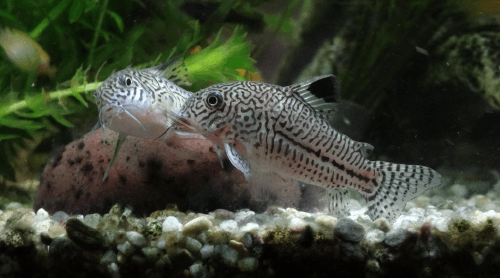
One of the rarer species of Corydoras on our list, Julii Corys are admired for their unique striped patterns.
Since true Julii Corys are generally hard to find, False Julii Corys (Corydoras trilineatus) are a great, more prevalent option for those who really love the striped pattern.
Like most other Cory species, Corydoras julii and Corydoras trilineatus are easy to care for and thrive in a range of water conditions.
- Scientific Name: Corydoras julii
- Size: 2.5″
- pH: 6.5-8.0
- Temperature: 72-80°F
Sterbai Cory
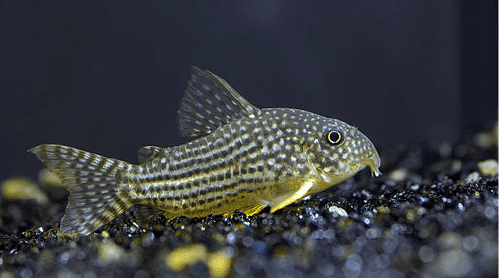
One of the most visually appealing species of Corydoras, Sterbai Corys are a favorite among freshwater fish-keepers.
They are known for their energetic, comical personalities and are very tolerant of different water conditions. Like most Corys, Sterbai grow to about 2.5 inches.
- Scientific Name: Corydoras sterbai
- Size: 2.5″
- pH: 6.0-7.5
- Temperature: 73-82°F
Pygmy Cory
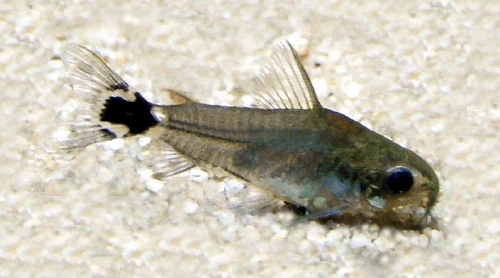
Pygmy Corys are definitely the most unique species of Cory catfish on our list. Topping out at around 1″, this species is capable of living in smaller aquarium than other types of Corys.
Unlike other Cory species, Pygmy Corys don’t spend all their time on the tank bottom – in fact, they prefer to swim about mid-tank.
- Scientific Name: Corydoras pygmaeus
- Size: 1″
- pH: 6.4-7.4
- Temperature: 72-80°F
Cory Catfish Tank Mates
Although Corydora species-only tanks can be incredible, most aquarium owners like a little variety. Luckily, Cory catfish are compatible with (pretty much) anything that won’t try to eat them.
Here are a few great Corydoras tank mates for those looking to put together a community tank:
Suitable Tankmates for Cory Catfish
- Mollies
- Fancy Guppies
- Platies
- Swordtails
- Neon Tetras
- Angelfish
- Danios
- Gouramis
Tankmates to Avoid
Here are a few species you definitely should not keep with Cory catfish:
- Cichlids: Cichlids in general tend to be too aggressive for Cories. Large species such as Oscars will outright eat them.
- Barbs: While Barbs aren’t overly aggressive, they are very nippy. Barbs often take advantage of the peaceful nature of Corydoras, causing stress and heavy competition for food.
Setting up a Cory Catfish Tank
If you’re looking to set up a Corydoras species-only tank, this is the section for you. We will go through everything you need to set up a gorgeous, natural Cory tank the right way.
Equipment
- Tank: While a lot of resources will tell you that Cory catfish are fine in 10 gallon tanks, I really disagree. I highly recommend going with a 20 or 30 gallon setup if you want to keep a healthy shoal of Corys.
- Filtration: If you want to go the extra mile, canister filters are a great way to step up your filtration. If not, no worries – a hang on back filter should be just fine. I recommend the AquaClear Power Filter.
- Heater: A heater is a vital part of keeping your tank stable. I’ve use the Cobalt Aquatics Neotherm for years with great results.
- Lighting: If you are going to keep live plants (which Corys love), you are going to need an LED light. The NICREW Classic is a great low-cost option.
Substrate
One of the most important pieces in any Cory catfish tank is the substrate. Unlike most freshwater fish, Corys DO NOT do well with gravel – the jagged edges can damage their fins and stomach.
Sand is, by far, the best option when it comes to keeping Cory Cats. I recommend CaribSea Super Naturals Sand (in the Sunset Gold color).
It is soft enough not to damage your Cory’s barbels and isn’t perfectly white, which helps the tank appear less dirty (white sand makes debris and algae much more visible).
If you don’t want to go with this sand, a lot of pool filter sands work great for Corys as well.
While sand it definitely your best option, it poses a problem with live plants. Sand has a low CEC (meaning it does not absorb nutrients well) – therefore, root tabs are necessary to supply your plants with the right nutrients.
Place them at the base of your plants underneath the substrate – within a few months, your sand should be mature enough that the root tabs will no longer be necessary
Adding Live Plants
Cory Cats are not picky at all when it comes to plants – in fact, just about any species should work. Here are a few beginner friendly aquarium plants that don’t require a ton of light or pristine water conditions:
- Anubias Nana
- Java Fern
- Crypts
- Pennywort
- Hornwort
- Java Moss
As we explained above, root tabs will be necessary for the first few months if you’re using any type of sand (especially for rooted plants). Once the tank matures, enough nutrients are absorbed into the substrate that the root tabs won’t be necessary.
In addition to plants, Cory Cats love hiding in driftwood and slate shelves. Feel free to get creative with your aquascaping and layout – this is the time for your creativity to shine!
Lighting
Live plants require good lighting to thrive.
I really recommend going with an LED fixture for multiple reasons – they last longer, they put off much less heat, and produce healthier plants. As suggested above, the NICREW Classic is a good choice for those on a budget.
Although lighting is important for plants, Cory Catfish tend to enjoy low light environments. That said, Corys are very adaptable and will adjust to just about any light you throw at them.
Just try to make sure there are a few caves or similar structures present so that your Corys can escape the light once in a while.
Cycling
This should go without saying, but make sure your tank is completely cycled before you introduce any fish. If you need any help with this process, read through our complete guide to the fishless cycle.
One of the best things about Cory Cat tanks (and planted tanks in general) is that it’s perfectly fine to add plants before cycling your aquarium. In fact, there is a lot of evidence that plants can actually help speed up the nitrogen cycle.
Use these few weeks to shop around for suitable plants, read about aquascaping, and getting your tank set up exactly how you want it.
Based on personal experience, giving your tank the proper time to cycle not only leads to a better laid out/more attractive tank, but also a healthier one.
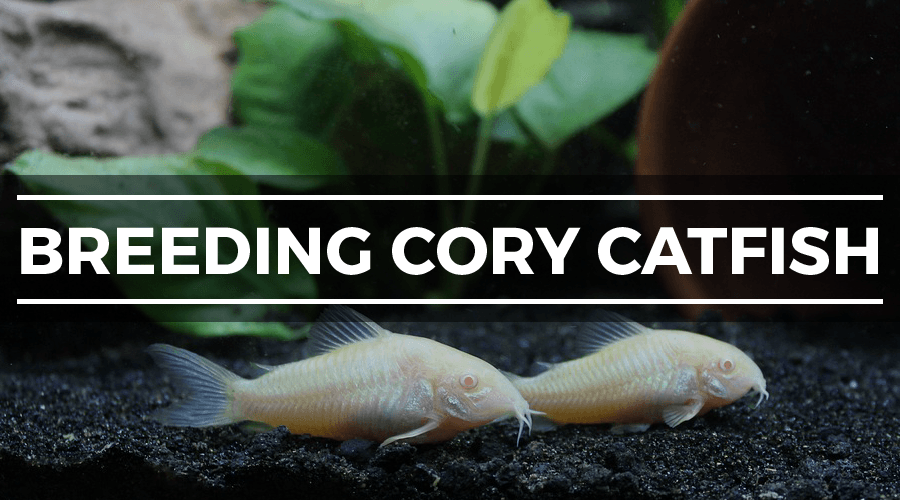
Breeding Cory Catfish
At some point, most Corydora owners want to breed their fish – luckily, breeding Cory Catfish is actually pretty easy.
In this section, we go through everything you know about setting up a breeding tank, encouraging spawning, and raising Cory fry.
Cory Breeding Setup
A huge part of successfully breeding Corys is having the right setup – after all, fish don’t spawn unless they feel comfortable and secure. Here are a few ways that you can approach putting together a breeding tank:
- Strategy #1 – Dedicated Breeding Aquarium: Most breeding guides will tell you that you need to set up a dedicated breeding aquarium separate from the “main” Cory tank. These tanks are usually bare and rarely have any substrate (which makes it easy to clean & raise fry in). This strategy involves removing the Cory breeding group from the main aquarium, acclimating them to the new tank, and encouraging them to breed. Once spawning is finished, the Corys are placed back in the main tank with the eggs being left behind in the breeding tank. This approach works best for those that are serious about having a high fry survival rate.
- Strategy #2 – Dedicated Fry Aquarium: With this strategy, Cory owners induce spawning in the “main” aquarium instead of transferring their fish to a breeding setup. Once spawning occurs, the eggs are transferred to a fry tank where they are hatched and raised. This setup is simpler and less stressful for your adult Corys – that said, fry survival rate tends to be a little lower than with strategy #1.
So which strategy is better? Of course, it depends.
The dedicated breeding tank route is great for those who keep their Corys in community aquariums. While they will still spawn with other species present, tank mates (and even the Corys themselves) will make a quick snack of the eggs.
In addition, having a dedicated breeding aquarium means that you won’t have to move the eggs/fry, which helps increase fry survival rates.
That said, moving your breeding colony back and forth from the main aquarium to the breeding tank can be very stressful for your Cories.
Personally, I prefer going with strategy #2 – I find it to be easier and safer for my fish. I may take a few tries to get the fry tank just right, but once your Cories start breeding you definitely won’t have any shortage of eggs.
Setting up a Fry Tank
Ideally, the fry tank should be set up early in the process – you want to give the aquarium enough time to stabilize before adding any delicate fry.
It may be tempting to add plants, decorations, and substrate to the fry tank, but that’s the exact opposite of what you should do.
The fry tank should be as simple as possible – completely bare is my preference. A bare aquarium is extremely easy to clean, which makes it much easier to keep water parameters stable (which is vital to keeping fry alive).
A 10 gallon aquarium should be fine starting out. Use water and filter media from the main tank – rub the filter media on the tank walls and anything else in the aquarium.
By transferring enough beneficial bacteria, you can completely skip the cycling process in the new fry tank.
For filtration, definitely go with a sponge filter. Anything else will likely be too strong and suck up the baby Cories. I suggest the Bacto-Surge High Density Sponge Filter.
Other than the bare aquarium, sponge filter, and heater, not much else is needed for the fry tank. Like we discussed above, try to keep it as simple as possible. Make sure that there are no traces of ammonia/nitrite and try to keep nitrates under 10ppm.
Determining the Gender of Corydoras
You’re going to need a mix of males and females if you want your Cories to breed (duh). Ideally, you want about 2 males for every female in the aquarium.
Unfortunately, there is no cut and dry method to determine the sex of Cory Catfish with 100% accuracy. That said, there are a few things you can look for.
Male Cories tend to be thin and “streamlined”. Females, on the other hand, are thicker around the midsection and tend to sit higher off the bottom.

Cory Catfish usually can’t be reliably sexed until they reach maturity, so don’t panic if you can’t get a good idea of genders at the fish store.
Instead of stressing out about determining genders right then and there, picking a random group of 6-8 Cories works just about every time.
Here are the chances of getting at least one male/female pair based on the number of fish you buy:
- 6 Cories: 98.43% of at least one pair
- 7 Cories: 99.21% of at least one pair
- 8 Cories: 99.60% of at least one pair
Conditioning Your Catfish
Well fed Cories are happy Cories – therefore, a high protein, nutritious diet is important in the spawning process. Feed your fish a mixture of live/frozen foods such as brine shrimp and bloodworms along with high-quality pellets or flakes.
I prefer to feed small quantities often throughout the day (maybe 4-5 times). Frequent feedings help signal that there’s no shortage of food, which helps induce breeding.
That said, make sure not to overdo it – keeping your water parameters in line should always be the #1 priority.
After a week or two of conditioning, you will notice your female Cories getting plump with eggs. This is a great sign and signals the perfect time to move on to the next step.
Inducing Your Cory Catfish to Spawn
Now that your Cories are well-fed and plump full of eggs, it’s time for the spawn! Some Cories will spawn without any enticing…other won’t.
For those that fall into the latter category, here is a trick that usually works without fail.
Do a large water change (25%-50%) with water that is slightly colder than your tank water (2-3°F cooler). The drop in temperature simulates summer rainfall, which is when Cories breed in the wild.
If your Cories don’t spawn within a few hours, empty out a bit more water and repeat the process again. Never let the water temperature get below 65°F.
Your Cories will most likely spawn the same day, but sometimes it takes a few days – don’t worry if it doesn’t happen right away.
Females usually lay their eggs on the tank wall, but sometime use plants, filters, or decorations instead (I have even seen them lay eggs on an Mystery Snail).
Caring for Cory Catfish Eggs
So you found eggs plastered all over the tank wall…what do you do now?
The first step is getting the eggs out of the main tank – the breeding colony of Cories are hungry after spawning and will usually eat their own eggs.
Use you finger, a credit card, or a razor to gently scrape the eggs off of the tank wall into a small container or net. Be very gentle with this step.
Next, transfer the eggs to the fry tank without exposing them to air. Don’t just throw them in the bottom of the tank though – put them in a breeder net with an air stone for water flow.
If you want something more official than a breeder net, egg tumblers are a great affordable option. They were designed specifically for the purpose of incubating fish eggs and do a great job at deterring fungus. I highly suggest the Cobalt Aquatics Egg Rocker.
Note: If you notice any eggs that turn white/fuzzy, remove them ASAP. These eggs are infertile and growing fungus, which can spread to good eggs given enough time.
Fry Care
Cory eggs usually hatch in 3-6 days. For the first few days, feeding your fry is unnecessary since they absorb nutrients from the egg sack attached to their body.
Once the egg sacks are absorbed and the fry are free swimming, start them on New Life Spectrum Fry Food. I’ve found this to be the most effective and easy to use food (much easier than raising your own baby brine shrimp). Dissolve a small pinch in a tiny bit of water and use a syringe/baster to squirt it as close to the fry as possible.
Your fry should start growing fast once they begin eating. It’s tempting to feed them a million times a day, but make sure you don’t dirty up the tank – fry need pristine water conditions to survive.
Once they are large enough, switch the fry over to dried brine shrimp or crushed up flakes. Try to add some variety in their diet early so they’re not picky later on (which shouldn’t be hard with Cory Cats).
At 3/4″ to 1″, you should be able to transfer your fry to the main tank, trade them for other species, or even sell them to your local fish store!
Frequently Asked Questions
A minimum tank size of 20 gallons is recommended for Corydoras.
Most Corydoras species stay between 2″ to 2.5″. Some species, such as Pygmy Corydoras, only get to about 1″ in length.
Corydoras are scavengers and do best on a mix of plant and meat based foods.
Cory Catfish are a schooling species and should be kept in groups on 5 to 6.


I have been raising & selling albino corys for a couple of years now. All good info! Only differance Ive found is eggs are very prone to fungus using method of transferring eggs to fry tank. I now always use methal blue and tumbler or air stones in breeder. Also, parents left with fry kept eggs clean (no methal blue needed) and laid around plants where hatched fry stayed until large enough to keep tank mates from consuming. Great acrobats when happy!
Hi Sheri! That is great to hear that you have had success raising and selling Albino Corydoras. I agree, Methylene Blue can be a huge help to keep eggs from developing fungus! I used to use that a lot back when I was breeding Angelfish.
I’ve had fungussed eggs hatch many times. It does not mean they are infertile. I have hatched with and w/o meth blue. I have added meth blue in the middle of a incubation period because eggs were starting to fungus and everyone of those eggs hatched. I always expose my eggs to open air when transferring as I don’t know of any other way to get them out of 1 tank and into the other.
Hi
We currently have a cory laying eggs in our aquarium.
Around 30 so far, that I have seen.
Most of the ones laid on the glass, have been eaten 🙁
I have managed to get a net over a few, that are on plants, and glass. Around 15 eggs. No fish can get to them.
Should I try to collect the eggs, and put them in a floating fry tank?
That’s the only thing I have.
If any manage to hatch, will they survive?
Any advice will be greatly appreciated
Thank you
Hi, i was wondering, my Cory eggs have hatched and the fry is about 3 weeks old now but i noticed there are all just laying on the bottom of the tank. If you com near them with your hand, they will get away so they are still alive but just laying still on the bottom. What am I doing wrong? I am afraid not much of them will survive
That’s all good to know. I want some of my eggs to hatch. I was wondering why she started laying eggs right after I did a tank cleaning, now I know. Not quite set up to transfer the eggs into a tumbler yet but, I’ll work on it.
Thank you
Is there anything out there that’s like a rug in place of substrate that I can take out and rinse instead of ”vacuuming” the tank?
Or something that’s very low maintenance.
I have five Green Cory catfish and one Betta, ( that actually likes to swim and eat with the Cory’s).
Thanks
Alice G
Hi, thank you for your info page. We had a pair of Cory, we lost our girl last night, we think she was egg bound. Our family were captivated by their dedication to each other, they were always within touching distance, slept together, Spot our male even petted Steve-e our female with his side fin. To on lookers you would say they were in love. They are remarkably fish. I would recommend them to any kind fish keeper.
What do you do if their wiskers become damaged
Question for you. My Corys have been spawning, they were pretty much eating the eggs as fast as they were laid, and so were the other fish. I found a few eggs that were sheltered behind a plant and figured they would be eaten too. I was cleaning the tank the other day and there was one baby under a plant! It was the size of a tadpole. Just curious if you think it will survive in the tank? I could not catch it to get it out. Also, about how quickly will it become about 1 inch in size?
i need help. i have a 20 gallon long tank with plants and good filtration but my corydoras arn´t breeding. i have 3 males and 2 female Bronze Corys. my temp is 78 degrees . my ph and every thing else is fine. i also feed them. i also haven’t see any eggs. plz some one help me.
I have several albino cories in a small pond in my backyard in FL with goldfish and gambuzia – any ideas on special care fir them? Pond is about 150 gallons, filtered by red mangroves and with water falling back into pond that is pumped up into 17 gallon buckets full of taro and pickerel weed in two corners. Pond is triangular with mangroves in the third corner about 18 inches deep in the middle with cinderblock swim through that all of the fish seem to like in the middle.
I have hatched albino corys. How big do they need to be before I release them with the other fish? They are in a breeding tank with the fish now and have been for a month or so. I dont want them to be eaten after all this time.